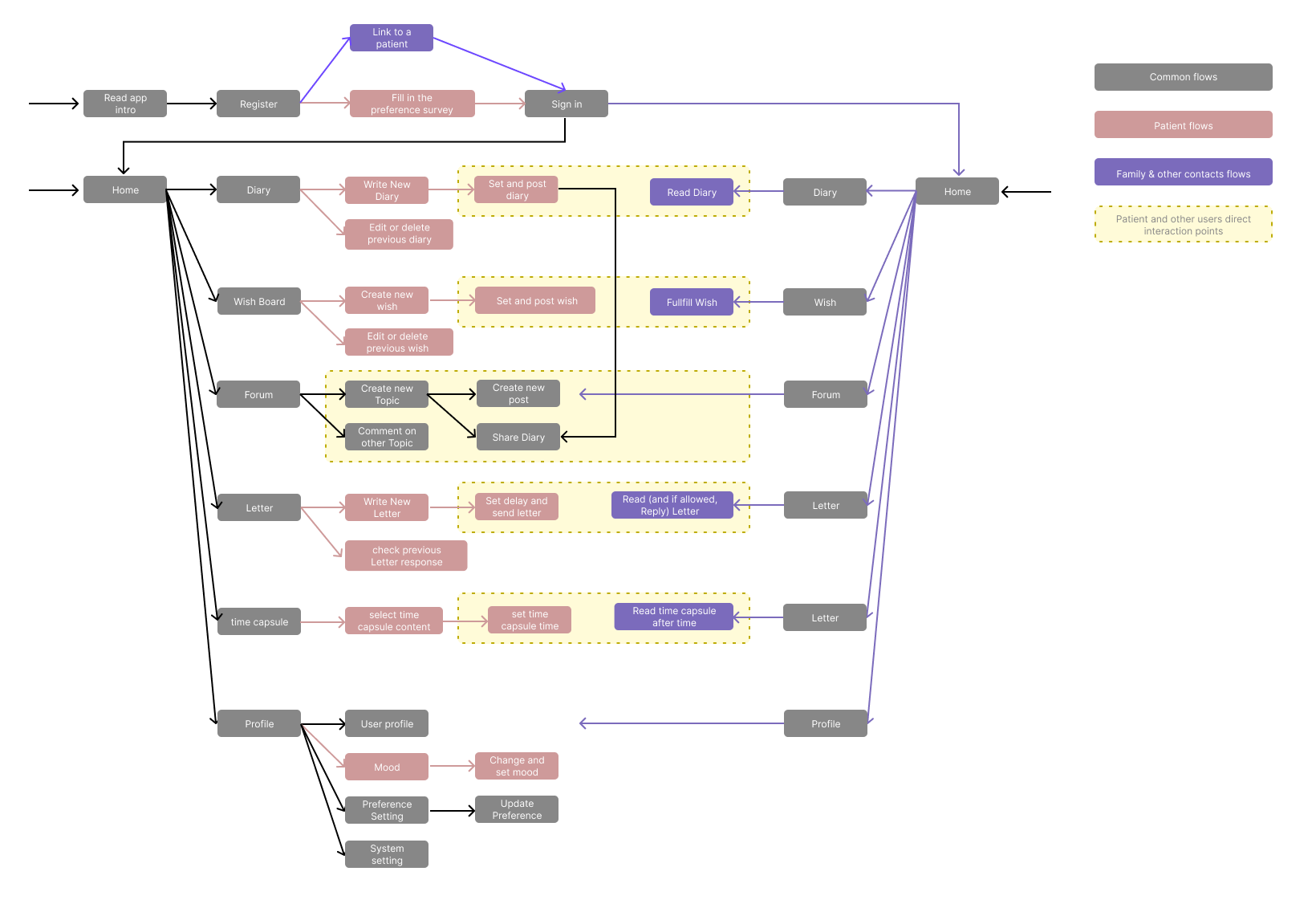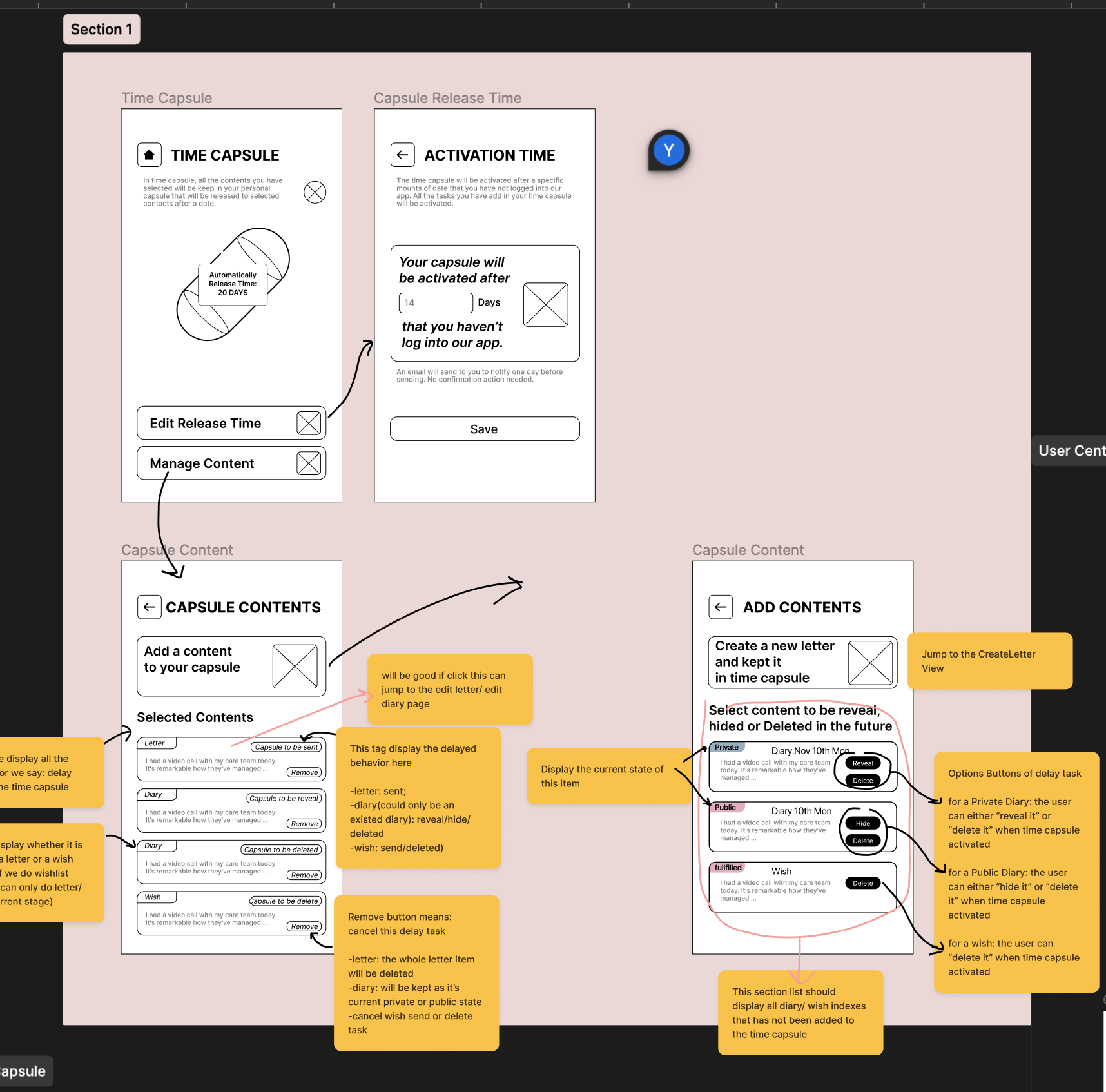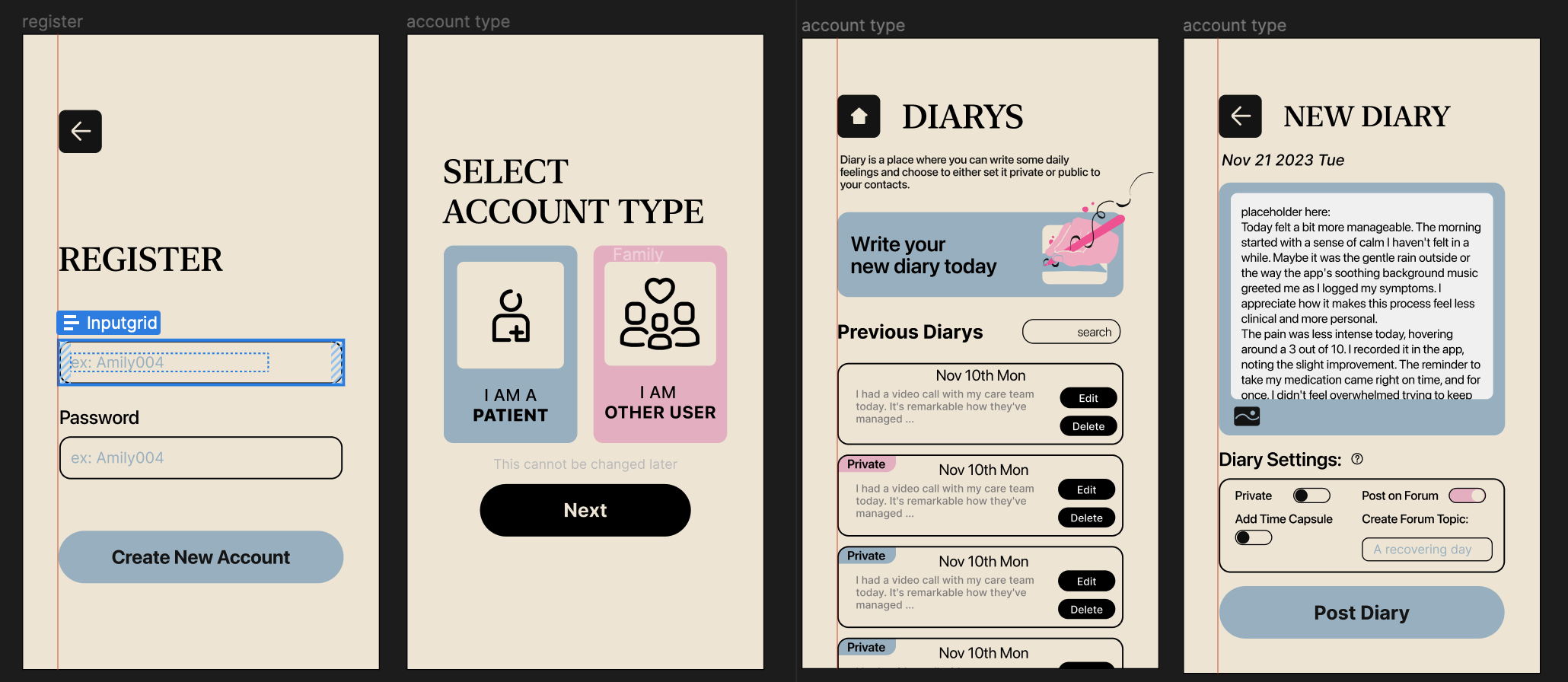Project 5: Beta
@Shaw Chen @Maggie @Yinghou Wang @Ethan
App Vercel
User Test Plan
Task table (patient user)
| Task Number | Short Title | User Instruction | Rationale |
|---|---|---|---|
| 1 | Register as Patient | Register for a new account, specifying that you are a patient. | To assess the registration process's ease and intuitiveness, particularly for new patients. |
| 2 | Set Mood | Set your current mood using the app's feature. | To evaluate the user-friendliness of mood setting and its relevance to the user experience. |
| 3 | Explore Forum | Browse and read topics on the Forum page. | To understand user engagement with community features and content relevance. |
| 4 | Create Public Diary | Create a new diary entry about your day and mark it as public. | To test diary creation functionality and privacy settings' clarity. |
| 5 | Edit Diary to Private | Edit your diary entry to be specifically about your diet today, and mark it private. | To assess the ease of editing diary entries and changing privacy settings. |
| 6 | Add Wish | Add a wish to your Wishlist about meeting your favorite celebrity. | To evaluate user interaction with the Wishlist feature and its appeal. |
| 7 | Delayed Letter Creation | Create a letter to an old friend and set a delay for sending it. | To test the functionality and user understanding of the delayed send feature. |
| 8 | Add to Time Capsule | Add your diary entry and your wish to your Time Capsule. | To determine how users interact with the Time Capsule feature and its perceived value. |
| 9 | New Letter to Time Capsule | Add a new letter to your Time Capsule. | To understand user behavior regarding saving communications for future reflection. |
| 10 | Remove Wish from Time Capsule | Remove the wish from your Time Capsule. | To assess the ease of modifying content within the Time Capsule. |
| 11 | Edit Diary in Time Capsule | Click on your Diary in the Time Capsule and edit it to talk about what you did last night. | To evaluate the user experience in editing and updating saved items in the Time Capsule. |
| 12 | Log Out | Log out of your account. | To ensure the log-out process is intuitive and secure. |
Task table (non-patient user)
| Task Number | Short Title | User Instruction | Rationale |
|---|---|---|---|
| 1 | Register as Non-Patient | Register as a non-patient user, indicating you have a patient contact. | To test the registration process for non-patient users and its distinction from patient registration. |
| 2 | Bounding via Passcode | During registration, bind to the patient user using a provided passcode. | To evaluate the security and ease of the bounding process between patient and non-patient users. |
| 3 | View and Reply to Letter | View a letter received from a patient and try to reply. | To assess the communication features and how non-patient users interact with patient users. |
| 4 | Access the Patient's Diary | View the bounded patient's diary entries. | To understand how non-patient users engage with patient's shared diary content. |
| 5 | Engage with Wishboard | View the patient's wishboard and attempt to fulfill one wish. | To evaluate the functionality and appeal of the wishboard feature for non-patient users. |
| 6 | Forum Interaction | Visit the forum and reply to a discussion. | To assess the forum's usability and the interaction dynamics among different user types. |
| 7 | Connect with Non-Patient on Forum | Find and interact with another non-patient user on the forum. | To explore the community aspect of the forum and interactions among non-patient users. |
| 8 | Log Out | Log out of your account. | To ensure the log-out process is clear and functions properly for non-patient users. |
App Design Revisions
1. Defining Non-Patient and Patient User Relationships
Our approach to connecting non-patient and patient users has evolved through several stages to better align with our design principles:
Initial Approach
- Friend Request System: Initially, we implemented a standard friend request system. This allowed non-patient users to send requests to connect with patient users.
First Revision
- Registration with Passcode: We modified the connection process to adhere to our 'patient-centered' design principle from P1: Impact Case. During registration, non-patient users require a passcode from the patient user. This establishes an initial connection and allows them to sign into our app.
Second Revision
- Connection via Forum Posts: We introduced a new connection method in response to our post forum's 'public social circle' feature. Non-patient users can now view patient profiles through forum posts and request to join their contact list, enabling connections with multiple patient users.
2. Delay for TimeCapsule
Our concept of 'Delay' has undergone a significant transformation:
Initial Concept
- Generic Delay Functionality: We initially planned for the Delay feature to be a generic concept applicable to various elements like Letters, Diaries, and Wishes.
Revised Implementation
- Specific to TimeCapsule: After careful consideration and during the implementation process, we decided to make the Delay feature exclusive to the TimeCapsule. This decision was based on the realization that the concept of Delay is most coherent and meaningful when applied specifically to the TimeCapsule in our app.
- Extend Time Capsule as an option for users in “diary,” “letter,” and “wishboard.” To make Time Capsule functionality more useful in our app, we make accessible options for users when they create new diary, letter, and wish.
3. Preference Setting
The design of our Preference Setting also underwent modifications driven by practical considerations and project constraints.
Initial Concept
- Periodically check users’ using habits and refresh their default settings
Revised Implementation
- Specify the “preference”: Due to the time limitation of this project, we specified the preference into two main functionalities: Vision Assistance and Time Capsule activation date. The first function is designed to serve the special visual needs of our users, and the second preference function addresses and assists our main innovative concept, “delay.”
4. Topic Instead of Forum
Initial Concept
- an environment conducive to discussion and collaboration among users
Revised Implementation
- Collection of Topics: What was previously categorized under Forum is now organized as a collection of individual Topics. This allows for more streamlined and topic-centric discussions.
- Diary to Topic Translation: A significant feature of this revision is the ability for patients to convert their diary entries into Topics. Should they choose to do so, their personal diary entries can be shared in the forum, transforming private reflections into public discussions.
5. Introduction of New Concept: Contact
We created a new concept to manage different types of users better
Revised Implementation
- Handling Diverse User Types: Contact is akin to the classic Friend concept but is tailored to handle different user categories, including 'patient,’ 'non-patient,’ 'in-app user,’ and 'email (non-app) user.’
- Flexibility in Connections: This system allows for seamless interactions between users regardless of their status or mode of app usage, ensuring that all users can connect and communicate effectively.
6. Restructure wireframe
We re-draw the Figma wireframe into a high-fidelity one and use an industrial standard frame to enhance the modularity of our front-end design and styling.
Revised Implementation
A clearer user flow

Reframe our interfaces based on revised concepts:

Hi-fi version frame with standardized layout and components
